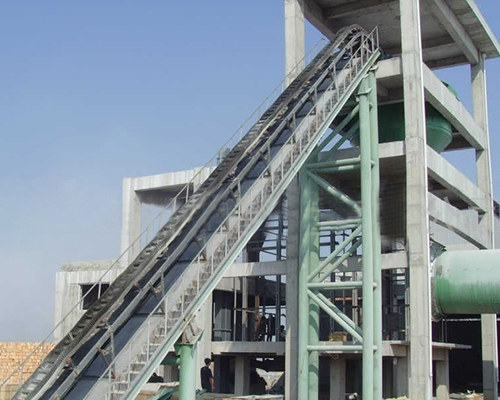The structural feature of
corrugated sidewall belt conveyor
The driving device, driving pulley, reversing pulley, tension device and conveyor roller of the main components of the large angle belt conveyor are common to the traditional belt conveyor, and the main differences with the general belt conveyor are as follows:
1.The conveyor belt adopts corrugated sidewall conveyor belt, and the adoption of other parts of the conveyor is related to this change;
2. Due to the diaphragm plate on the conveyor belt, relevant ways should be taken to feed materials into conveyor for avoiding collision between materials and baffles;
3.When the running directions of conveyor belts changes, it is necessary to set the necessary conveyor belt’s guide device and set the pressure roller at concave curve (including carrying branch and return branch);
4. In the return branch, a part similar to the traditional belt conveyor is used to limit the swing of the conveyor belt. Generally, the roller can be directly applied. When the gravity of the belt is large, it is necessary to consider the rigidity of the rib or the baffle, and set a special roller;
5.Since the conveyor belt is equipped with baffle, sweepers that touch the inner surface of the conveyor belt must be used.
Corrugated sidewall belts
The general
corrugated sidewall conveyor belt is composed of a base belt, a corrugated sidewall and a baffle. The base belt acts like a traditional conveyor belt and is the traction element of the conveyor that withstands tension. Since it is difficult to support the conveyor belt, it is required that the base belt lateral direction should have sufficient rigidity by adding a special reinforcing layer in the lateral direction of the base belt core, However, appropriate flexibility should be maintained in the longitudinal direction to facilitate the bending of conveyor belt through the roller and in the convex and concave sections. The corrugated sidewall is used to increase the cross section of the load material. The reason why the sidewall is corrugated is that when the conveyor belt passes through the pulley and the convex and concave arc segments, the sidewall is not subject to excessive additional tensile and compressive stress, and can be freely stretched. The corrugated sidewall conveyor belt is divided into four types according to a combination of a base belt, a baffle, and a corrugated sidewall. The combination of the corrugated sidewall conveyor belts depends on the inclination of the conveyor and the arrangement of the conveyor.
Structural arrangement of corrugated sidewall belt conveyor
Due to the ability of conveying material in large angle of the corrugated sidewall belt conveyor, the arrangement is very flexible. According to the typical line layout of the conveyor horizontal section, there can be various types. Only the inclined (or vertical) section, it is called I-shaped; the horizontal section is L-shaped at the lower part, its upper branch has a concave arc section, the lower branch has a convex arc section; the horizontal section is in the upper part of the inverse L-shape, and its upper branch has a convex arc section, The branch has a concave arc section; in the upper and lower portions of the conveyor, there are horizontal sections called S-shaped and SC-shaped, and the upper branch and the lower branch each have a convex arc section and a concave arc section. In the structural design of the
corrugated sidewall belt conveyor, the design of the convex arc and the concave arc is an important content. In the curved section of the conveyor belt, under the action of tension, it has the force to leave the design curve, so the design task of the curved section is to provide the necessary support for the conveyor belt to ensure that the conveyor belt runs according to the designed curve. The necessary support is also required in the straight section to ensure that the conveyor belt does not cause an impact on the conveyor system due to excessive swinging, and vibration is prevented.





